www.developer.com/services/article.php/1602051
Back to
Article
WSDL
Essentials
By
February 25, 2003
This is Chapter 6: WSDL Essentials from the book Web
Services Essentials (ISBN:0-596-00224-6) written by Ethan
Cerami, published by O'Reilly
& Associates.
© Copyright O'Reilly & Associates. All rights
reserved.
Chapter 6
WSDL
Essentials
WSDL is a specification defining how to describe web
services in a common XML grammar. WSDL describes four critical pieces of
data:
- Interface information describing all publicly
available functions
- Data type information for all message requests and
message responses
- Binding information about the transport protocol to
be used
- Address information for locating the specified
service
In a nutshell, WSDL represents a contract between the
service requestor and the service provider, in much the same way that a
Java interface represents a contract between client code and the actual
Java object. The crucial difference is that WSDL is platform- and
language-independent and is used primarily (although not exclusively) to
describe SOAP services.
Using WSDL, a client can locate a web service and invoke any
of its publicly available functions. With WSDL-aware tools, you can also
automate this process, enabling applications to easily integrate new
services with little or no manual code. WSDL therefore represents a
cornerstone of the web service architecture, because it provides a common
language for describing services and a platform for automatically
integrating those services.
This chapter covers all aspects of WSDL, including the
following topics:
- An overview of the WSDL specification, complete
with detailed explanations of the major WSDL elements
- Two basic WSDL examples to get you started
- A brief survey of WSDL invocation tools, including
the IBM Web Services Invocation Framework (WSIF), SOAP::Lite, and The
Mind Electric's GLUE platform
- A discussion of how to automatically generate WSDL
files from existing SOAP services
- An overview of using XML Schema types within WSDL,
including the use of arrays and complex types
The WSDL Specification
WSDL is an XML grammar for describing web services. The
specification itself is divided into six major elements:
definitions
- The
definitions
element must be the root element of all WSDL documents. It defines the
name of the web service, declares multiple namespaces used throughout
the remainder of the document, and contains all the service elements
described here.
types
- The
types element
describes all the data types used between the client and server. WSDL is
not tied exclusively to a specific typing system, but it uses the W3C
XML Schema specification as its default choice. If the service uses only
XML Schema built-in simple types, such as strings and integers, the
types element is not required. A full
discussion of the types element and XML
Schema is deferred to the end of the chapter.
message
- The
message element
describes a one-way message, whether it is a single message request or a
single message response. It defines the name of the message and contains
zero or more message part elements, which can
refer to message parameters or message return values.
portType
- The
portType element
combines multiple message elements to form a
complete one-way or round-trip operation. For example, a portType can combine one request and one response
message into a single request/response operation, most commonly used in
SOAP services. Note that a portType can (and
frequently does) define multiple operations.
binding
- The
binding element
describes the concrete specifics of how the service will be implemented
on the wire. WSDL includes built-in extensions for defining SOAP
services, and SOAP-specific information therefore goes here.
service
- The
service element
defines the address for invoking the specified service. Most commonly,
this includes a URL for invoking the SOAP service.
To help you keep the meaning of each element clear, Figure
6-1 offers a concise representation of the WSDL specification. As you
continue reading the remainder of the chapter, you may wish to refer back
to this diagram.
Figure 6-1. The WSDL specification in a nutshell
|
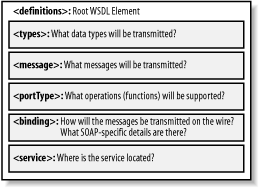
|
In addition to the six major elements, the WSDL
specification also defines the following utility elements:
documentation
- The
documentation
element is used to provide human-readable documentation and can be
included inside any other WSDL element.
import
- The
import element is
used to import other WSDL documents or XML Schemas. This enables more
modular WSDL documents. For example, two WSDL documents can import the
same basic elements and yet include their own service elements to make the same service available
at two physical addresses. Note, however, that not all WSDL tools
support the import functionality as of yet.
TIP: WSDL is not an official
recommendation of the W3C and, as such, has no official status within
the W3C. WSDL Version 1.1 was submitted to the W3C in March 2001.
Original submitters included IBM, Microsoft, Ariba, and a half dozen
other companies. Most probably, WSDL will be placed under the
consideration of the new W3C Web Services Activity's Web Services
Description Working Group, which will decide if the specification
advances to an official recommendation status. The WSDL Version 1.1
specification is available online at http://www.w3.org/TR/wsdl.
Basic WSDL Example:
HelloService.wsdl
To make the previously described WSDL concepts as concrete
as possible, let's examine our first sample WSDL file.
Example 6-1 provides a sample HelloService.wsdl document. The document describes the
HelloService from Chapter 4.
As you may recall, the service provides a single publicly
available function, called sayHello. The function
expects a single string parameter, and returns a single string greeting.
For example, if you pass the parameter world,
the service returns the greeting, "Hello, world!"
Example 6-1: HelloService.wsdl <?xml version="1.0" encoding="UTF-8"?>
<definitions name="HelloService"
targetNamespace="http://www.ecerami.com/wsdl/HelloService.wsdl"
xmlns="http://schemas.xmlsoap.org/wsdl/"
xmlns:soap="http://schemas.xmlsoap.org/wsdl/soap/"
xmlns:tns="http://www.ecerami.com/wsdl/HelloService.wsdl"
xmlns:xsd="http://www.w3.org/2001/XMLSchema">
<message name="SayHelloRequest">
<part name="firstName" type="xsd:string"/>
</message>
<message name="SayHelloResponse">
<part name="greeting" type="xsd:string"/>
</message>
<portType name="Hello_PortType">
<operation name="sayHello">
<input message="tns:SayHelloRequest"/>
<output message="tns:SayHelloResponse"/>
</operation>
</portType>
<binding name="Hello_Binding" type="tns:Hello_PortType">
<soap:binding style="rpc"
transport="http://schemas.xmlsoap.org/soap/http"/>
<operation name="sayHello">
<soap:operation soapAction="sayHello"/>
<input>
<soap:body
encodingStyle="http://schemas.xmlsoap.org/soap/encoding/"
namespace="urn:examples:helloservice"
use="encoded"/>
</input>
<output>
<soap:body
encodingStyle="http://schemas.xmlsoap.org/soap/encoding/"
namespace="urn:examples:helloservice"
use="encoded"/>
</output>
</operation>
</binding>
<service name="Hello_Service">
<documentation>WSDL File for HelloService</documentation>
<port binding="tns:Hello_Binding" name="Hello_Port">
<soap:address
location="http://localhost:8080/soap/servlet/rpcrouter"/>
</port>
</service>
</definitions>
The WSDL elements are discussed in the next section of this
chapter. As you examine each element in detail, you may want to refer to
Figure 6-2, which summarizes the most important aspects of Example 6-1.
Figure 6-2. A bird's-eye view of HelloService.wsdl
|
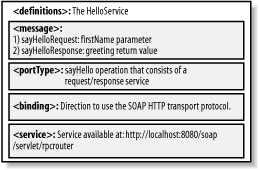
|
definitions
The definitions element specifies
that this document is the HelloService. It also
specifies numerous namespaces that will be used throughout the remainder
of the document: <definitions name="HelloService"
targetNamespace="http://www.ecerami.com/wsdl/HelloService.wsdl"
xmlns="http://schemas.xmlsoap.org/wsdl/"
xmlns:soap="http://schemas.xmlsoap.org/wsdl/soap/"
xmlns:tns="http://www.ecerami.com/wsdl/HelloService.wsdl"
xmlns:xsd="http://www.w3.org/2001/XMLSchema">
The use of namespaces is important for differentiating
elements, and it enables the document to reference multiple external
specifications, including the WSDL specification, the SOAP specification,
and the XML Schema specification.
The definitions element also
specifies a targetNamespace attribute. The
targetNamespace is a convention of XML Schema
that enables the WSDL document to refer to itself. In Example 6-1, we
specified a targetNamespace of http://www.ecerami.com/wsdl/HelloService.wsdl. Note,
however, that the namespace specification does not require that the
document actually exist at this location; the important point is that you
specify a value that is unique, different from all other namespaces that
are defined.
Finally, the definitions element
specifies a default namespace:
xmlns=http://schemas.xmlsoap.org/wsdl/. All elements without a
namespace prefix, such as message or portType, are therefore assumed to be part of the
default WSDL namespace.
message
Two message elements are defined.
The first represents a request message, SayHelloRequest, and the second represents a response
message, SayHelloResponse: <message name="SayHelloRequest">
<part name="firstName" type="xsd:string"/>
</message>
<message name="SayHelloResponse">
<part name="greeting" type="xsd:string"/>
</message>
Each of these messages contains a single part element. For the request, the part specifies the
function parameters; in this case, we specify a single firstName parameter. For the response, the part
specifies the function return values; in this case, we specify a single
greeting return value.
The part element's type attribute specifies an XML Schema data type. The
value of the type attribute must be specified
as an XML Schema QName--this means that the value
of the attribute must be namespace-qualified. For example, the firstName type attribute
is set to xsd:string; the xsd prefix references the namespace for XML Schema,
defined earlier within the definitions element.
If the function expects multiple arguments or returns
multiple values, you can specify multiple part
elements.
portType
The portType element defines a
single operation, called sayHello. The operation
itself consists of a single input message (SayHelloRequest) and a single output message (SayHelloResponse): <portType name="Hello_PortType">
<operation name="sayHello">
<input message="tns:SayHelloRequest"/>
<output message="tns:SayHelloResponse"/>
</operation>
</portType>
Much like the type attribute
defined earlier, the message attribute must be
specified as an XML Schema QName. This means that the value of the
attribute must be namespace-qualified. For example, the input element specifies a message attribute of tns:SayHelloRequest; the tns prefix references the targetNamespace defined earlier within the definitions element.
WSDL supports four basic patterns of operation:
- One-way
- The service receives a message. The operation
therefore has a single
input element.
- Request-response
- The service receives a message and sends a
response. The operation therefore has one
input element, followed by one output element (illustrated previously in Example
6-1). To encapsulate errors, an optional fault element can also be specified.
- Solicit-response
- The service sends a message and receives a
response. The operation therefore has one
output element, followed by one input element. To encapsulate errors, an optional
fault element can also be specified.
- Notification
- The service sends a message. The operation
therefore has a single
output element.
These patterns of operation are also shown in Figure 6-3.
The request-response pattern is most commonly used in SOAP services.
Figure 6-3. Operation patterns supported by WSDL 1.1
|
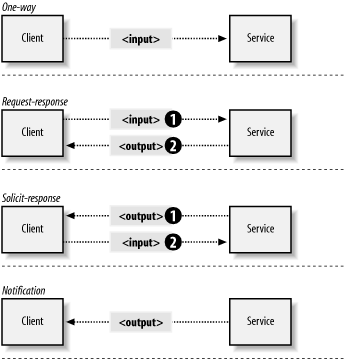
|
binding
The binding element provides
specific details on how a portType operation
will actually be transmitted over the wire. Bindings can be made available
via multiple transports, including HTTP GET, HTTP POST, or SOAP. In fact,
you can specify multiple bindings for a single portType.
The binding element itself
specifies name and type attributes: <binding name="Hello_Binding" type="tns:Hello_PortType">
The type attribute references the
portType defined earlier in the document. In
our case, the binding element therefore
references tns:Hello_PortType, defined earlier
in the document. The binding element is therefore saying, "I will provide
specific details on how the sayHello operation
will be transported over the Internet."
SOAP binding
WSDL 1.1 includes built-in extensions for SOAP 1.1. This
enables you to specify SOAP-specific details, including SOAP headers, SOAP
encoding styles, and the SOAPAction HTTP
header. The SOAP extension elements include:
soap:binding
- This element indicates that the binding will be
made available via SOAP. The
style attribute
indicates the overall style of the SOAP message format. A style value of rpc
specifies an RPC format. This means that the body of the SOAP request
will include a wrapper XML element indicating the function name.
Function parameters are then embedded inside the wrapper element.
Likewise, the body of the SOAP response will include a wrapper XML
element that mirrors the function request. Return values are then
embedded inside the response wrapper element.
- A
style value of document specifies an XML document call format.
This means that the request and response messages will consist simply of
XML documents. The document style is flatter than the rpc style and does not require the use of wrapper
elements. (See the upcoming note for additional details.)
- The
transport
attribute indicates the transport of the SOAP messages. The value http://schemas.xmlsoap.org/soap/http indicates the SOAP HTTP transport, whereas http://schemas.xmlsoap.org/soap/smtp indicates the
SOAP SMTP transport.
soap:operation
- This element indicates the binding of a specific
operation to a specific SOAP implementation. The
soapAction attribute specifies that the SOAPAction HTTP header be used for identifying the
service. (See Chapter 3 for details on the SOAPAction header.)
soap:body
- This element enables you to specify the details
of the input and output messages. In the case of HelloWorld, the
body element specifies the SOAP encoding style and
the namespace URN associated with the specified service.
TIP: The choice between the rpc style and the document style is controversial. The topic has
been hotly debated on the WSDL newsgroup (http://groups.yahoo.com/group/wsdl).
The debate is further complicated because not all WSDL-aware tools
even differentiate between the two styles. Because the rpc style is more in line with the SOAP examples
from previous chapters, I have chosen to stick with the rpc style for all the examples within this
chapter. Note, however, that most Microsoft .NET WSDL files use the
document style.
service
The service element specifies the
location of the service. Because this is a SOAP service, we use the soap:address element, and specify the local host
address for the Apache SOAP rpcrouter servlet:
http://localhost:8080/soap/servlet/rpcrouter.
Note that the service element includes a documentation element to provide human-readable
documentation.
WSDL Invocation Tools, Part I
Given the WSDL file in Example 6-1, you could manually
create a SOAP client to invoke the service. A better alternative is to automatically invoke the service via a WSDL invocation
tool. (See Figure 6-4.)
Figure 6-4. WSDL invocation tools
|
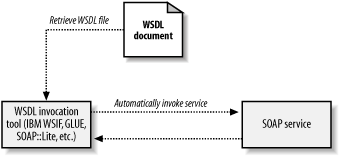
|
Many WSDL invocation tools already exist. This section
provides a brief overview of three invocation tools.
GLUE
The Mind Electric provides a complete web service platform
called GLUE (available at http://www.themindelectric.com/).
The platform itself provides extensive support for SOAP, WSDL, and UDDI.
Some of its advanced functionality, including support for complex data
types, will be explored later in this chapter.
For now, you can try out the GLUE invoke command-line tool. Here is the command-line
usage: usage: invoke URL method arg1 arg2 arg3...
For example, to invoke the HelloService, make sure that your
Apache Tomcat server is running, and place the HelloService.wsdl file within a publicly available
directory. Then, issue the following command: invoke http://localhost:8080/wsdl/HelloService.wsdl sayHello World
Once invoked, GLUE will immediately download the specified
WSDL file, invoke the sayHello method, and pass
World as a parameter. GLUE will then
automatically display the server response: Output: result = Hello, World!
That's all there is to it!
GLUE also supports an excellent logging facility that
enables you to easily view all SOAP messages. To activate the logging
facility, set the electric.logging system
property. The easiest option is to modify the invoke.bat file. The original file looks like this: call java electric.glue.tools.Invoke %1 %2 %3 %4 %5 %6 %7 %8 %9
Modify the file to include the logging property via the
-D option to the Java interpreter: call java -Delectric.logging="SOAP" electric.glue.tools.Invoke %1 %2 %3 %4
%5 %6 %7 %8 %9
When you invoke the HelloService, GLUE now generates the
following output: LOG.SOAP: request to http://207.237.201.187:8080/soap/servlet/rpcrouter
<?xml version='1.0' encoding='UTF-8'?>
<soap:Envelope
xmlns:xsi='http://www.w3.org/2001/XMLSchema-instance'
xmlns:xsd='http://www.w3.org/2001/XMLSchema'
xmlns:soap='http://schemas.xmlsoap.org/soap/
envelope/' xmlns:soapenc='http://schemas.xmlsoap.org/soap/encoding/'
soap:encodingStyle='http://schemas.xmlsoap.org/soap/encoding/'>
<soap:Body>
<n:sayHello xmlns:n='urn:examples:helloservice'>
<firstName xsi:type='xsd:string'>World</firstName>
</n:sayHello>
</soap:Body>
</soap:Envelope>
LOG.SOAP: response from http://207.237.201.187:8080/soap/servlet/rpcrouter
<?xml version='1.0' encoding='UTF-8'?>
<SOAP-ENV:Envelope
xmlns:SOAP-ENV='http://schemas.xmlsoap.org/soap/envelope/'
xmlns:xsi='http://www.w3.org/1999/XMLSchema-instance'
xmlns:xsd='http://www.w3.org/1999/XMLSchema'>
<SOAP-ENV:Body>
<ns1:sayHelloResponse
xmlns:ns1='urn:examples:helloservice'
SOAP-ENV:encodingStyle=
'http://schemas.xmlsoap.org/soap/encoding/'>
<return xsi:type='xsd:string'>Hello, World!</return>
</ns1:sayHelloResponse>
</SOAP-ENV:Body>
</SOAP-ENV:Envelope>
result = Hello, World!
To view additional HTTP information, just set electric.logging to SOAP,HTTP.
SOAP::Lite for Perl
SOAP::Lite for Perl, written by Paul Kulchenko, also
provides limited support for WSDL. The package is available at http://www.soaplite.com.
Example 6-2 provides a complete Perl program for invoking
the HelloService.
Example 6-2: Hello_Service.pl use SOAP::Lite;
print "Connecting to Hello Service...\n";
print SOAP::Lite
-> service('http://localhost:8080/wsdl/HelloService.wsdl')
-> sayHello ('World');
The program generates the following output: Connecting to Hello Service...
Hello, World!
IBM Web Services Invocation Framework (WSIF)
Finally, IBM has recently released WSIF. The package is
available at http://www.alphaworks.ibm.com/tech/wsif.
Much like GLUE, WSIF provides a simple command-line option
for automatically invoking WSDL services. For example, the following
command: java clients.DynamicInvoker http://localhost:8080/wsdl/HelloService.wsdl
sayHello World
generates the following output: Reading WSDL document from 'http://localhost:8080/wsdl/HelloService.wsdl'
Preparing WSIF dynamic invocation
Executing operation sayHello
Result:
greeting=Hello, World!
Done!
Basic WSDL Example: XMethods eBay Price Watcher
Service
Before moving on to more complicated WSDL examples, let's
examine another relatively simple one. Example 6-3 provides a WSDL file
for the XMethods eBay Price Watcher Service. The service takes an existing
eBay auction ID, and returns the value of the current bid.
Example 6-3: eBayWatcherService.wsdl (reprinted with permission of
XMethods, Inc.) <?xml version="1.0"?>
<definitions name="eBayWatcherService"
targetNamespace=
"http://www.xmethods.net/sd/eBayWatcherService.wsdl"
xmlns:tns="http://www.xmethods.net/sd/eBayWatcherService.wsdl"
xmlns:xsd="http://www.w3.org/2001/XMLSchema"
xmlns:soap="http://schemas.xmlsoap.org/wsdl/soap/"
xmlns="http://schemas.xmlsoap.org/wsdl/">
<message name="getCurrentPriceRequest">
<part name="auction_id" type = "xsd:string"/>
</message>
<message name="getCurrentPriceResponse">
<part name="return" type = "xsd:float"/>
</message>
<portType name="eBayWatcherPortType">
<operation name="getCurrentPrice">
<input
message="tns:getCurrentPriceRequest"
name="getCurrentPrice"/>
<output
message="tns:getCurrentPriceResponse"
name="getCurrentPriceResponse"/>
</operation>
</portType>
<binding name="eBayWatcherBinding" type="tns:eBayWatcherPortType">
<soap:binding
style="rpc"
transport="http://schemas.xmlsoap.org/soap/http"/>
<operation name="getCurrentPrice">
<soap:operation soapAction=""/>
<input name="getCurrentPrice">
<soap:body
use="encoded"
namespace="urn:xmethods-EbayWatcher"
encodingStyle="http://schemas.xmlsoap.org/soap/encoding/"/>
</input>
<output name="getCurrentPriceResponse">
<soap:body
use="encoded"
namespace="urn:xmethods-EbayWatcher"
encodingStyle="http://schemas.xmlsoap.org/soap/encoding/"/>
</output>
</operation>
</binding>
<service name="eBayWatcherService">
<documentation>
Checks current high bid for an eBay auction
</documentation>
<port name="eBayWatcherPort" binding="tns:eBayWatcherBinding">
<soap:address
location="http://services.xmethods.net:80/soap/servlet/rpcrouter"/>
</port>
</service>
</definitions>
Here is an overview of the main WSDL elements:
messages
- Two messages are defined:
getCurrentPriceRequest and getCurrentPriceResponse. The request message
contains a single string parameter; the response message contains a
single float parameter.
portType
- A single operation,
getCurrentPrice, is defined. Again, we see the
request/response operation pattern.
binding
- The
binding element
specifies HTTP SOAP as the transport. The soapAction attribute is left as an empty string
("").
service
- This element specifies that the service is
available at http://services.xmethods.net/soap/servlet/rpcrouter.
To access the eBay watcher service, you can use any of the
WSDL invocation tools defined earlier. For example, the following call to
GLUE: invoke http://www.xmethods.net/sd/2001/EBayWatcherService.wsdl
getCurrentPrice 1271062297
retrieves the current bid price for a Handspring Visor
Deluxe: result = 103.5
TIP: The XMethods web site (http://www.xmethods.net/) provides
dozens of sample SOAP and .NET services. Nearly all of these services
include WSDL files and therefore provide an excellent opportunity for
learning WSDL in detail. As you browse the XMethods directory, try
interfacing with the specified services via any of the WSDL invocation
tools described here. Quite likely, you will be amazed at how easy it is
to integrate and invoke new services.
|
WSDL Invocation Tools, Part II
Our initial discussion of WSDL invocation tools focused on
programming and command-line invocation tools. We now move on to even
simpler tools that are entirely driven by a web-based interface.
The GLUE Console
In addition to supporting a number of command-line tools,
the GLUE platform also supports a very intuitive web interface for
deploying new services and connecting to existing services.
To start the GLUE console, just type:
console
This will automatically start the GLUE console on the
default port 8100. Open a web browser and you will see the GLUE console
home page. (See Figure 6-5.)
Figure 6-5. The GLUE console: index page
|
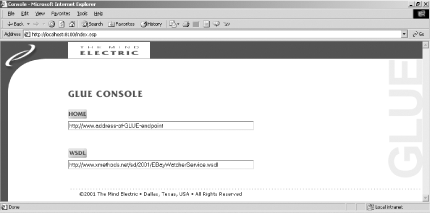
|
In the text box entitled WSDL, you can enter the URL for any
WSDL file. For example, try entering the URL for the eBay Price Watcher
Service, http://www.xmethods.net/sd/2001/EBayWatcherService.wsdl.
Click the WSDL button, and you will see the Web Service
overview page. (See Figure 6-6.) This page includes a description of the
specified service (extracted from the WSDL document element) and a list of public operations. In
the case of the eBay service, you should see a single getCurrentPrice method.
Figure 6-6. The GLUE console: Web Service overview page for the
eBay Price Watcher Service
|
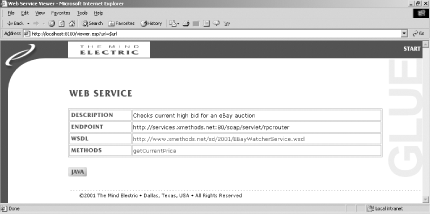
|
Click the getCurrentPrice method,
and you will see the Web Method overview page. (See Figure 6-7.) This page
includes a text box where you can specify the input auction ID.
Figure 6-7. The GLUE console: Web Method overview page for the
getCurrentPrice method
|

|
Enter an auction ID, click the Send button, and GLUE will
automatically invoke the remote method and display the results at the
bottom of the page. For example, Figure 6-8 shows the current bid price
for the Handspring Visor Deluxe. Note that the price has already gone up
$10 since invoking the service via the GLUE command-line tool!
Figure 6-8. The GLUE console: invoking the getCurrentPrice method
(results of the invocation are displayed at the bottom of the
screen)
|
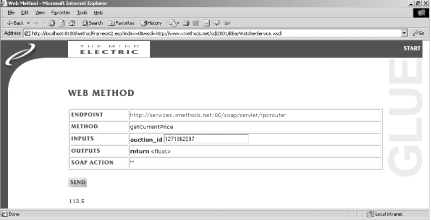
|
SOAPClient.com
If you would like to try out a web-based interface similar
to GLUE, but don't want to bother downloading the GLUE package, consider
the Generic SOAP Client available at SOAPClient.com.
Figure 6-9 shows the opening screen to the Generic SOAP
Client. Much like the GLUE console, you can specify the address for a WSDL
file in this screen.
Figure 6-9. The Generic SOAP Client, available from
SOAPClient.com
|
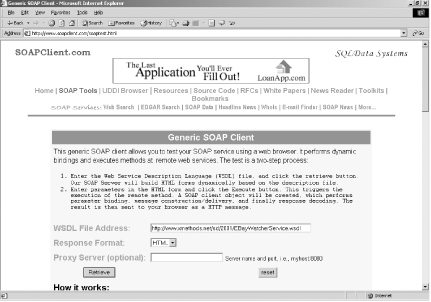
|
Specify the same eBay Price Watcher Service WSDL file, and
the SOAP Client will display a text box for entering the auction ID. (See
Figure 6-10.)
Figure 6-10. The Generic SOAP Client: Displaying information on the
XMethods eBay Price Watcher Service
|
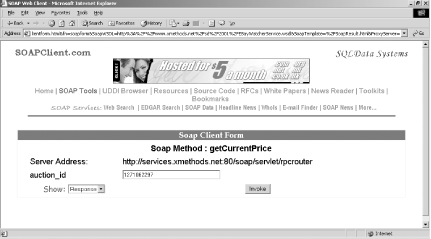
|
Figure 6-11 displays the result of the eBay service
invocation. The Handspring Visor is up another $4!
Figure 6-11. The Generic SOAP Client: Response from the XMethods
eBay Price Watcher Service
|
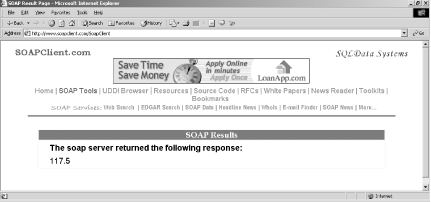
|
Automatically Generating WSDL Files
One of the best aspects of WSDL is that you rarely have to
create WSDL files from scratch. A whole host of tools currently exists for
transforming existing services into WSDL descriptions. You can then choose
to use these WSDL files as is or manually tweak them with your favorite
text editor. In the discussion that follows, we explore the WSDL
generation tool provided by GLUE.
TIP: If you create WSDL files from scratch
or tweak WSDL files generated by a tool, it is a good idea to validate
your final WSDL documents. You can download a WSDL validator from http://pocketsoap.com/wsdl/. This
package requires that you have an XSLT engine and the zvonSchematron (http://www.zvon.org/), but installation
only takes a few minutes. Once installed, the validator is well worth
the effort and creates nicely formatted HTML reports indicating WSDL
errors and warnings.
GLUE java2wsdl Tool
The GLUE platform includes a java2wsdl command-line tool for transforming Java
services into WSDL descriptions. The command-line usage is as follows:
usage: java2wsdl <arguments>
where valid arguments are:
classname name of java class
-d directory output directory
-e url endpoint of service
-g include GET/POST binding
-m map-file read mapping instructions
-n namespace namespace for service
-r description description of service
-s include SOAP binding
-x command-file command file to execute
Complete information on each argument is available online
within the GLUE User Guide at http://www.themindelectric.com/products/glue/releases/GLUE-1.1/docs/guide/index.html.
For now, we will focus on the most basic arguments.
For example, consider the PriceService class in Example 6-4. The service
provides a single getPrice( ) method.
Example 6-4: PriceService.java
package com.ecerami.soap.examples;
import java.util.Hashtable;
/**
* A Sample SOAP Service
* Provides Current Price for requested Stockkeeping Unit (SKU)
*/
public class PriceService {
protected Hashtable products;
/**
* Zero Argument Constructor
* Load product database with two sample products
*/
public PriceService ( ) {
products = new Hashtable( );
// Red Hat Linux
products.put("A358185", new Double (54.99));
// McAfee PGP Personal Privacy
products.put("A358565", new Double (19.99));
}
/**
* Provides Current Price for requested SKU
* In a real-setup, this method would connect to
* a price database. If SKU is not found, method
* will throw a PriceException.
*/
public double getPrice (String sku)
throws ProductNotFoundException {
Double price = (Double) products.get(sku);
if (price == null) {
throw new ProductNotFoundException ("SKU: "+sku+" not found");
}
return price.doubleValue( );
}
}
To generate a WSDL file for this class, run the following
command:
java2wsdl com.ecerami.soap.examples.PriceService -s -e http://localhost:
8080/soap/servlet/rpcrouter -n urn:examples:priceservice
The -s option directs GLUE to
create a SOAP binding; the -e option specifies
the address of our service; and the -n option
specifies the namespace URN for the service. GLUE will generate a PriceService.wsdl file. (See Example 6-5.)
TIP: If your service is defined via a
Java interface and you include your source files within your CLASSPATH,
GLUE will extract your Javadoc comments, and turn these into WSDL documentation elements.
Example 6-5: PriceService.wsdl (automatically generated by GLUE)
<?xml version='1.0' encoding='UTF-8'?>
<!--generated by GLUE-->
<definitions name='com.ecerami.soap.examples.PriceService'
targetNamespace='http://www.themindelectric.com/wsdl/com.ecerami.soap.
examples.PriceService/'
xmlns:tns='http://www.themindelectric.com/wsdl/com.ecerami.soap.
examples.PriceService/'
xmlns:electric='http://www.themindelectric.com/'
xmlns:soap='http://schemas.xmlsoap.org/wsdl/soap/'
xmlns:http='http://schemas.xmlsoap.org/wsdl/http/'
xmlns:mime='http://schemas.xmlsoap.org/wsdl/mime/'
xmlns:xsd='http://www.w3.org/2001/XMLSchema'
xmlns:soapenc='http://schemas.xmlsoap.org/soap/encoding/'
xmlns:wsdl='http://schemas.xmlsoap.org/wsdl/'
xmlns='http://schemas.xmlsoap.org/wsdl/'>
<message name='getPrice0SoapIn'>
<part name='sku' type='xsd:string'/>
</message>
<message name='getPrice0SoapOut'>
<part name='Result' type='xsd:double'/>
</message>
<portType name='com.ecerami.soap.examples.PriceServiceSoap'>
<operation name='getPrice' parameterOrder='sku'>
<input name='getPrice0SoapIn' message='tns:getPrice0SoapIn'/>
<output name='getPrice0SoapOut' message='tns:getPrice0SoapOut'/>
</operation>
</portType>
<binding name='com.ecerami.soap.examples.PriceServiceSoap'
type='tns:com.ecerami.soap.examples.PriceServiceSoap'>
<soap:binding style='rpc'
transport='http://schemas.xmlsoap.org/soap/http'/>
<operation name='getPrice'>
<soap:operation soapAction='getPrice' style='rpc'/>
<input name='getPrice0SoapIn'>
<soap:body use='encoded'
namespace='urn:examples:priceservice'
encodingStyle='http://schemas.xmlsoap.org/soap/encoding/'/>
</input>
<output name='getPrice0SoapOut'>
<soap:body use='encoded'
namespace='urn:examples:priceservice'
encodingStyle='http://schemas.xmlsoap.org/soap/encoding/'/>
</output>
</operation>
</binding>
<service name='com.ecerami.soap.examples.PriceService'>
<port name='com.ecerami.soap.examples.PriceServiceSoap'
binding='tns:com.ecerami.soap.examples.PriceServiceSoap'>
<soap:address location='http://207.237.201.187:8080
/soap/servlet/ rpcrouter'/>
</port>
</service>
</definitions>
You can then invoke the service via SOAP::Lite:
use SOAP::Lite;
print "Connecting to Price Service...\n";
print SOAP::Lite
-> service('http://localhost:8080/wsdl/PriceService.wsdl')
-> getPrice ('A358185');
Hopefully, this example illustrates the great promise of web
service interoperability. We have a WSDL file generated by GLUE, a server
running Java, and a client running Perl, and they all work seamlessly
together.
Connecting to Price Service...
54.99
WARNING: The IBM Web Services Toolkit
(available at http://www.alphaworks.ibm.com/tech/webservicestoolkit)
provides a WSDL generation tool called wsdlgen. This tool can take existing Java classes,
Enterprise JavaBeans, and Microsoft COM objects and automatically
generate corresponding WSDL files. However, as this book goes to press,
the wsdlgen tool creates files based on the
1999 version of the W3C XML Schema. The WSDL files are therefore
incompatible with other WSDL invocation tools, such as SOAP::Lite and
GLUE. If you choose to use the IBM tool, make sure to manually update
your WSDL files to reflect the latest version of XML Schema (http://www.w3.org/2001/XMLSchema).
XML Schema Data Typing
In order for a SOAP client to communicate effectively with a
SOAP server, the client and server must agree on a data type system. By
default, XML 1.0 does not provide a data type system. In contrast, every
programming language provides some basic facility for declaring data
types, such as integers, floats, doubles, and strings. One of the greatest
challenges in building web services is therefore creating a common data
type system that can be used by a diverse set of programming languages
running on a diverse set of operating systems.
WSDL does not aim to create a standard for XML data typing.
In fact, WSDL is specifically designed for maximum flexibility and is
therefore not tied exclusively to any one data type system. Nonetheless,
WSDL does default to the W3C XML Schema specification. The XML Schema
specification is also currently the most widely used specification for
data typing.
The more you know about XML Schemas, the better you can
understand complex WSDL files. A full discussion of XML Schemas is beyond
the scope of this chapter. However, two facts are crucially important.
First, the XML Schema specification includes a basic type
system for encoding most data types. This type system includes a long list
of built-in simple types, including strings, floats, doubles, integers,
time, and date. This list, shown in Table 6-1, is excerpted from the XML
Schema Part 0: Primer (http://www.w3org/TR/2000/WD=xmlschema=0=20000407/).
If your application sticks to these simple data types, there is no need to
include the WSDL types element, and the
resulting WSDL file is extremely simple. For example, our first two WSDL
files use only strings and floats.
Table 6-1: A list of the main XML Schema built-in simple types
|
Simple type |
Example(s) |
|
string |
Web Services |
|
Boolean |
true, false, 1, 0 |
|
float |
-INF, -1E4, -0, 0, 12.78E-2, 12, INF, NaN
|
|
double |
-INF, -1E4, -0, 0, 12.78E-2, 12, INF, NaN
|
|
decimal |
-1.23, 0, 123.4, 1000.00 |
|
binary |
100010 |
|
integer |
-126789, -1, 0, 1, 126789 |
|
nonPositiveInteger |
-126789, -1, 0 |
|
negativeInteger |
-126789, -1 |
|
long |
-1, 12678967543233 |
|
int |
-1, 126789675 |
|
short |
-1, 12678 |
|
byte |
-1, 126 |
|
nonNegativeInteger |
0, 1, 126789 |
|
unsignedLong |
0, 12678967543233 |
|
unsignedInt |
0, 1267896754 |
|
unsignedShort |
0, 12678 |
|
unsignedByte |
0, 126 |
|
positiveInteger |
1, 126789 |
|
date |
1999-05-31 |
|
time |
13:20:00.000, 13:20:00.000-05:00
|
Second, the XML Schema specification provides a facility for
creating new data types. This is important if you
want to create data types that go beyond what is already defined within
the Schema. For example, a service might return an array of floats or a
more complex stock quote object containing the high, low, and volume
figures for a specific stock. Whenever your service goes beyond the simple
XML Schema data types, you must declare these new data types within the
WSDL types element.
In the next two sections of this chapter, we present two
specific examples of using XML Schemas to create new data types. The first
focuses on arrays; the second focuses on a more complex data type for
encapsulating product information.
Arrays
Example 6-6, shown later in this section, is a sample WSDL
file that illustrates the use of arrays. This is the Price List Service we
created in Chapter 5. The service has one public method, called getPriceList, which expects an array of string SKU
values and returns an array of double price values.
The WSDL file now includes a types element. Inside this element, we have defined
two new complex types. Very broadly, the XML Schema defines simple types
and complex types. Simple types cannot have element children or
attributes, whereas complex types can have element children and
attributes. We have declared complex types in our WSDL file, because an
array may have multiple elements, one for each value in the array.
The XML Schema requires that any new type you create be
based on some existing data type. This existing base type is specified via
the base attribute. You can then choose to
modify this base type using one of two main methods: extension or restriction.
Extension simply means that your new data type will have all the
properties of the base type plus some extra functionality. Restriction
means that your new data type will have all the properties of the base
data type, but may have additional restrictions placed on the data.
In Example 6-6, we'll create two new complex types via
restriction. For example:
<complexType name="ArrayOfString">
<complexContent>
<restriction base="soapenc:Array">
<attribute ref="soapenc:arrayType"
wsdl:arrayType="string[]"/>
</restriction>
</complexContent>
</complexType>
Example 6-6: PriceListService.wsdl
<?xml version="1.0" encoding="UTF-8"?>
<definitions name="PriceListService"
targetNamespace="http://www.ecerami.com/wsdl/PriceListService.wsdl"
xmlns="http://schemas.xmlsoap.org/wsdl/"
xmlns:soap="http://schemas.xmlsoap.org/wsdl/soap/"
xmlns:tns="http://www.ecerami.com/wsdl/PriceListService.wsdl"
xmlns:xsd="http://www.w3.org/2001/XMLSchema"
xmlns:xsd1="http://www.ecerami.com/schema">
<types>
<schema xmlns="http://www.w3.org/2001/XMLSchema"
targetNamespace="http://www.ecerami.com/schema"
xmlns:wsdl="http://schemas.xmlsoap.org/wsdl/"
xmlns:soapenc="http://schemas.xmlsoap.org/soap/encoding/">
<complexType name="ArrayOfString">
<complexContent>
<restriction base="soapenc:Array">
<attribute ref="soapenc:arrayType"
wsdl:arrayType="string[]"/>
</restriction>
</complexContent>
</complexType>
<complexType name="ArrayOfDouble">
<complexContent>
<restriction base="soapenc:Array">
<attribute ref="soapenc:arrayType"
wsdl:arrayType="double[]"/>
</restriction>
</complexContent>
</complexType>
</schema>
</types>
<message name="PriceListRequest">
<part name="sku_list" type="xsd1:ArrayOfString"/>
</message>
<message name="PriceListResponse">
<part name="price_list" type="xsd1:ArrayOfDouble"/>
</message>
<portType name="PriceList_PortType">
<operation name="getPriceList">
<input message="tns:PriceListRequest"/>
<output message="tns:PriceListResponse"/>
</operation>
</portType>
<binding name="PriceList_Binding" type="tns:PriceList_PortType">
<soap:binding style="rpc" transport="http://schemas.xmlsoap.org/soap/http"/>
<operation name="getPriceList">
<soap:operation soapAction="urn:examples:pricelistservice"/>
<input>
<soap:body
encodingStyle="http://schemas.xmlsoap.org/soap/encoding/"
namespace="urn:examples:pricelistservice"
use="encoded"/>
</input>
<output>
<soap:body
encodingStyle="http://schemas.xmlsoap.org/soap/encoding/"
namespace="urn:examples:pricelistservice" use="encoded"/>
</output>
</operation>
</binding>
<service name="PriceList_Service">
<port name="PriceList_Port" binding="tns:PriceList_Binding">
<soap:address location="http://localhost:8080/soap/servlet/rpcrouter"/>
</port>
</service>
</definitions>
The WSDL specification requires that arrays be based on the
SOAP 1.1 encoding schema. It also requires that arrays use the name ArrayOfXXX, where XXX is
the type of item in the array. The previous example therefore creates a
new type called ArrayOfString. This new type is
based on the SOAP array data type, but it is restricted to holding only
string values. Likewise, the ArrayOfDouble data
type creates a new array type containing only double values.
When using the WSDL types
element, you need to be particularly aware of XML namespace issues. First,
note that the root schema element must include
a namespace declaration for the SOAP encoding specification (http://schemas.xmlsoap.org/soap/encoding/).
This is required because our new data types extend the array definition
specified by SOAP.
Second, the root schema element
must specify a targetNamespace attribute. Any
newly defined elements, such as our new array data types, will belong to
the specified targetNamespace. To reference
these data types later in the document, you must refer back to the same
targetNamespace. Hence, our definitions element includes a new namespace
declaration:
xmlns:xsd1="http://www.ecerami.com/schema">
xsd1 matches the targetNamespace and therefore enables us to reference
the new data types later in the document. For example, the message element references the xsd1:ArrayOfString data type:
<message name="PriceListRequest">
<part name="sku_list" type="xsd1:ArrayOfString"/>
</message>
TIP: For an excellent and concise overview
of W3C Schema complex types and their derivation via extension and
restriction, see Donald Smith's article on "Understanding W3C Schema
Complex Types." The article is available online at http://www.xml.com/pub/a/2001/08/22/easyschema.html.
Automatically invoking array services
Once you move beyond basic data types, the simple WSDL
invocation methods described previously in this chapter no longer work
quite as easily. For example, you cannot simply open the GLUE console,
pass an array of strings, and hope to receive back an array of doubles.
Additional work is necessary, and some manual code is required.
Nonetheless, the additional work is minimal, and the discussion that
follows focuses on the GLUE platform. We have chosen to focus on the GLUE
platform because it represents the most elegant platform for working with
complex data types; other tools, such as the IBM Web Services Toolkit, do,
however, provide similar functionality.
To get started, you should become familiar with the GLUE
wsdl2java command-line tool. The tool takes in
a WSDL file and generates a suite of Java class files to automatically
interface with the specified service. You can then write your own Java
class to invoke the specified service. Best of all, the code you write is
minimally simple, and all SOAP-specific details are completely hidden from
your view. (See Figure 6-12.)
Figure 6-12. The GLUE wsdl2java tool and the GLUE architecture
|
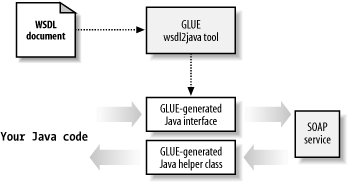
|
Here is the wsdl2java
command-line usage:
usage: wsdl2java <arguments>
where valid arguments are:
http://host:port/filename URL of WSDL
-c checked exceptions
-d directory output directory for files
-l user password realm login credentials
-m map-file read mapping instructions
-p package set default package
-v verbose
-x command-file command file to execute
Complete information on each argument is available online
within the GLUE User Guide at http://www.themindelectric.com/products/glue/releases/GLUE-1.1/docs/guide/index.html.
For now, we will focus on the most basic arguments. For example, to
generate Java class files for the PriceListService.wsdl file, first make sure that the
WSDL file is available publicly on a web site or locally via a web server
such as Tomcat. Then, issue the following command:
wsdl2java.bat http://localhost:8080/wsdl/PriceListService.wsdl -p com.
ecerami.wsdl.glue
The first argument specifies the location of the WSDL file;
the second argument specifies that the generated files should be placed in
the package com.ecerami.wsdl.glue.
GLUE will automatically download the specified WSDL file and
generate two Java class files:
write file IPriceList_Service.java
write file PriceList_ServiceHelper.java
The first file, IPriceList_Service.java, is shown in Example 6-7. This
file represents a Java interface that mirrors the public methods exposed
by the WSDL file. Specifically, the interface shows a getPriceList( ) method that receives an array of
String values, and returns an array of double values.
Example 6-7: IPriceList_Service.java
// generated by GLUE
package com.ecerami.wsdl.glue;
public interface IPriceList_Service
{
double[] getPriceList( String[] sku_list );
}
The second file, PriceList_ServiceHelper.java, is shown in Example 6-8.
This is known as a GLUE helper file, and it can dynamically bind to the
service specified by the WSDL file. To access the service, simply call the
static bind( ) method.
Example 6-8: PriceList_ServiceHelper.java
// generated by GLUE
package com.ecerami.wsdl.glue;
import electric.registry.Registry;
import electric.registry.RegistryException;
public class PriceList_ServiceHelper
{
public static IPriceList_Service bind( ) throws RegistryException
{
return bind( "http://localhost:8080/wsdl/PriceListService.wsdl" );
}
public static IPriceList_Service bind( String url )
throws RegistryException
{
return (IPriceList_Service)
Registry.bind( url, IPriceList_Service.class );
}
}
Once GLUE has generated the interface and helper files, you
just need to write your own class that actually invokes the service.
Example 6-9 shows a sample application that invokes the Price List
Service. The code first calls PriceList_ServiceHelper.bind( ), which then returns
an IPriceList_Service object. All subsequent
code behaves as if the Price List Service is a local object, and all
SOAP-specific details are completely hidden from the developer.
Here is a sample output of the Invoke_PriceList application:
Product Catalog
SKU: A358185 --> Price: 54.99
SKU: A358565 --> Price: 19.99
Example 6-9: Invoke_PriceList.java
package com.ecerami.wsdl;
import com.ecerami.wsdl.glue.*;
/**
* SOAP Invoker. Uses the PriceListServiceHelper to invoke
* SOAP service. PriceListServiceHelper and IPriceListService
* are automatically generated by GLUE.
*/
public class Invoke_PriceList {
/**
* Get Product List via SOAP
*/
public double[] getPrices (String skus[]) throws Exception {
IPriceList_Service priceListService = PriceList_ServiceHelper.bind( );
double[] prices = priceListService.getPriceList(skus);
return prices;
}
/**
* Main Method
*/
public static void main (String[] args) throws Exception {
Invoke_PriceList invoker = new Invoke_PriceList( );
System.out.println ("Product Catalog");
String skus[] = {"A358185", "A358565" };
double[] prices = invoker.getPrices (skus);
for (int i=0; i<prices.length; i++) {
System.out.print ("SKU: "+skus[i]);
System.out.println (" --> Price: "+prices[i]);
}
}
}
Complex Types
Our final topic is the use of complex data types. For
example, consider a home monitoring service that provides a concise update
on your home. The data returned could include multiple data elements, such
as the current temperature, security status, and whether the garage door
is open or closed. Encoding this data into WSDL requires additional
knowledge of XML Schemas, which reinforces the main precept that the more
you know about XML Schemas, the better you will understand complex WSDL
files.
To explore complex types, consider the WSDL file in Example
6-10. This WSDL file describes our Product Service from Chapter 5. The
complex types are indicated in bold.
Example 6-10: ProductService.wsdl
<?xml version="1.0" encoding="UTF-8"?>
<definitions name="ProductService"
targetNamespace="http://www.ecerami.com/wsdl/ProductService.wsdl"
xmlns="http://schemas.xmlsoap.org/wsdl/"
xmlns:soap="http://schemas.xmlsoap.org/wsdl/soap/"
xmlns:tns="http://www.ecerami.com/wsdl/ProductService.wsdl"
xmlns:xsd="http://www.w3.org/2001/XMLSchema"
xmlns:xsd1="http://www.ecerami.com/schema">
<types>
<xsd:schema
targetNamespace="http://www.ecerami.com/schema"
xmlns="http://www.w3.org/2001/XMLSchema">
<xsd:complexType name="product">
<xsd:sequence>
<xsd:element name="name" type="xsd:string"/>
<xsd:element name="description" type="xsd:string"/>
<xsd:element name="price" type="xsd:double"/>
<xsd:element name="SKU" type="xsd:string"/>
</xsd:sequence>
</xsd:complexType>
</xsd:schema>
</types>
<message name="getProductRequest">
<part name="sku" type="xsd:string"/>
</message>
<message name="getProductResponse">
<part name="product" type="xsd1:product"/>
</message>
<portType name="Product_PortType">
<operation name="getProduct">
<input message="tns:getProductRequest"/>
<output message="tns:getProductResponse"/>
</operation>
</portType>
<binding name="Product_Binding" type="tns:Product_PortType">
<soap:binding style="rpc"
transport="http://schemas.xmlsoap.org/soap/http"/>
<operation name="getProduct">
<soap:operation soapAction="urn:examples:productservice"/>
<input>
<soap:body
encodingStyle="http://schemas.xmlsoap.org/soap/encoding/"
namespace="urn:examples:productservice"
use="encoded"/>
</input>
<output>
<soap:body
encodingStyle="http://schemas.xmlsoap.org/soap/encoding/"
namespace="urn:examples:productservice" use="encoded"/>
</output>
</operation>
</binding>
<service name="Product_Service">
<port name="Product_Port" binding="tns:Product_Binding">
<soap:address location="http://localhost:8080/soap/servlet/rpcrouter"/>
</port>
</service>
</definitions>
The service in Example 6-10 describes a getProduct operation that returns a complex product type for encapsulating product information,
including product name, description, price, and SKU number.
The new product type is defined in much the same manner as
the array definition from the previous example. The main difference is
that we are now using the sequence element. The
sequence element specifies a list of
subelements and requires that these elements appear in the order
specified. XML Schemas also enable you to specify cardinality via the
minOccurs and maxOccurs attributes. If these attributes are absent
(as in our example), they default to 1,
requiring that each subelement must occur exactly one time.
Each subelement can also have its own data type, and you can
see that we have mixed and matched string data types with double data
types in our example.
Automatically invoking complex type services
To automatically invoke the Product Service, we return to
the GLUE wsdl2java tool. This time around, GLUE
will generate a Java interface class and a Java helper class, along with
two additional files for handling the new complex type.
For example, the following command:
wsdl2java.bat http://localhost:8080/wsdl/ProductService.wsdl -p com.ecerami.
wsdl.glue
generates the following output:
write file IProduct_Service.java
write file Product_ServiceHelper.java
write file product.java
write file Product_Service.map
The first two files in the output listing are familiar. The
first file is a Java interface mirroring the service; the second file is a
helper class for dynamically binding to the specified service. (See
Example 6-11 and Example 6-12.)
Example 6-11: IProduct_Service.java
// generated by GLUE
package com.ecerami.wsdl.glue;
public interface IProduct_Service
{
product getProduct( String sku );
}
Example 6-12: Product_ServiceHelper.java
// generated by GLUE
package com.ecerami.wsdl.glue;
import electric.registry.Registry;
import electric.registry.RegistryException;
public class Product_ServiceHelper
{
public static IProduct_Service bind( ) throws RegistryException
{
return bind( "http://localhost:8080/wsdl/ProductService.wsdl" );
}
public static IProduct_Service bind( String url )
throws RegistryException
{
return (IProduct_Service)
Registry.bind( url, IProduct_Service.class );
}
}
The third file in the output listing, product.java, represents a simple container class for
encapsulating product data. (See Example 6-13.) GLUE essentially takes all
the complex types defined within the WSDL file and creates a container
class for each type. Each subelement is then transformed into a public
variable for easy access. For example, the product class has four public variables, name, description, price, and SKU,
corresponding to our new complex data type. Note also that the public
variables match the XML Schema types specified within the WSDL file; for
example, name is declared as a String, whereas price is
declared as a double.
Example 6-13: product.java
// generated by GLUE
package com.ecerami.wsdl.glue;
public class product
{
public java.lang.String name;
public java.lang.String description;
public double price;
public java.lang.String SKU;
}
Finally, GLUE generates a Java-to-XML Schema mapping file.
(See Example 6-14.) The file itself is extremely concise and is
responsible for converting Java to XML Schema types and vice versa. (See
Figure 6-13.) The root complexType element
indicates that elements of type product should
be transformed into the product class located
in com.ecerami.wsdl.glue. Inside the root
complex type, there is a one-to-one mapping between the XML Schema type
and the public Java variable. For example, the element name is mapped to the product.name variable, and the type is specified as
string. Likewise, the element price is mapped to the product.price variable, and the type is specified as
double.
Figure 6-13. The GLUE Java-to-XML Schema mapping file
|

|
Example 6-14: Product_Service.map
<?xml version='1.0' encoding='UTF-8'?>
<!--generated by GLUE-->
<mappings xmlns='http://www.themindelectric.com/schema/'>
<schema
xmlns='http://www.w3.org/2001/XMLSchema'
targetNamespace='http://www.ecerami.com/schema'
xmlns:electric='http://www.themindelectric.com/schema/'>
<complexType name='product' electric:class='com.ecerami.wsdl.glue.product'>
<sequence>
<element name='name' electric:field='name' type='string'/>
<element name='description'
electric:field='description' type='string'/>
<element name='price' electric:field='price' type='double'/>
<element name='SKU' electric:field='SKU' type='string'/>
</sequence>
</complexType>
</schema>
</mappings>
To invoke the Product Service, you must first explicitly
load the mapping file via the GLUE Mappings
class:
Mappings.readMappings("Product_Service.map");
You can then access the service just like in the previous
example. See Example 6-15 for the complete invocation program. Here is
some sample output:
Product Service
Name: Red Hat Linux
Description: Red Hat Linux Operating System
Price: 54.99
Example 6-15: Invoke_Product.java
package com.ecerami.wsdl;
import java.io.IOException;
import electric.xml.io.Mappings;
import electric.xml.ParseException;
import electric.registry.RegistryException;
import com.ecerami.wsdl.glue.*;
/**
* SOAP Invoker. Uses the Product_ServiceHelper to invoke the Product
* SOAP service. All other .java files are automatically generated
* by GLUE.
*/
public class Invoke_Product {
/**
* Get Product via SOAP Service
*/
public product getProduct (String sku) throws Exception {
// Load Java <--> XML Mapping
Mappings.readMappings("Product_Service.map");
// Invoke Service
IProduct_Service service = Product_ServiceHelper.bind( );
product prod = service.getProduct(sku);
return prod;
}
/**
* Main Method
*/
public static void main (String[] args) throws Exception {
Invoke_Product invoker = new Invoke_Product( );
System.out.println ("Product Service");
product prod = invoker.getProduct("A358185");
System.out.println ("Name: "+prod.name);
System.out.println ("Description: "+prod.description);
System.out.println ("Price: "+prod.price);
}
}
This is a very small amount of code, but it is capable of
doing very real work. Be sure to check The Mind Electric web site (http://themindelectric.com/) for
new releases of the GLUE product.
About the Author
Ethan Cerami is a Software Engineer at the Institute for Computational
Biomedicine at Mount Sinai School of Medicine and an Adjunct Faculty at
NYU's Department of Computer Science. He is also the author of Delivering
Push (McGraw-Hill, 1998) and co-author with Simon St. Laurent of Building
XML Applications (McGraw-Hill, 2000).
Source of this material
To access the full Table of Contents for the book
Legal Notices,
Licensing,
Reprints,
& Permissions,
Privacy
Policy.
Advertise on EarthWeb













